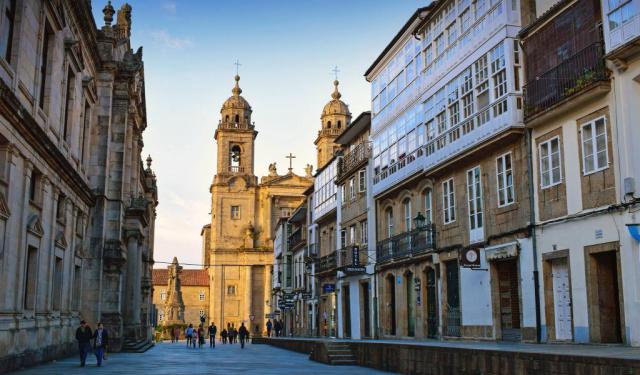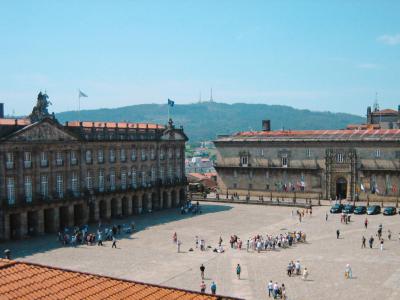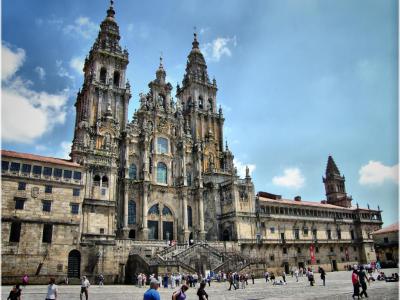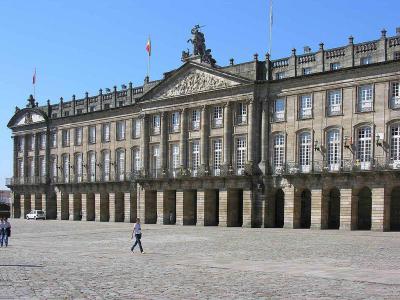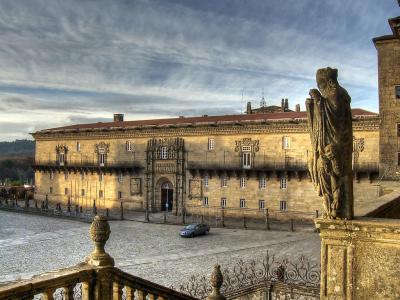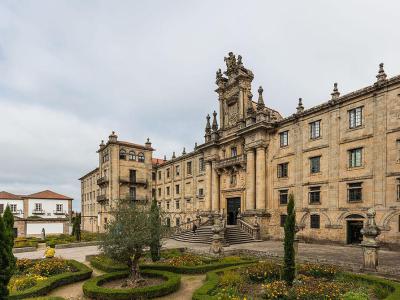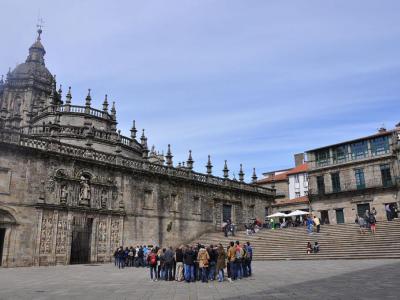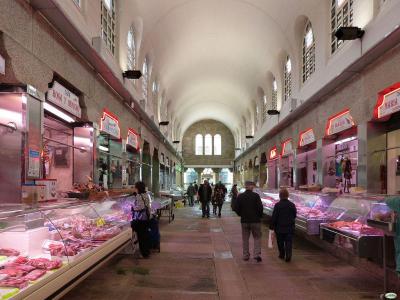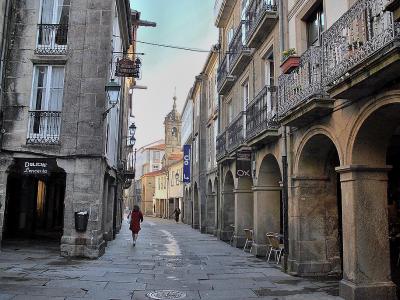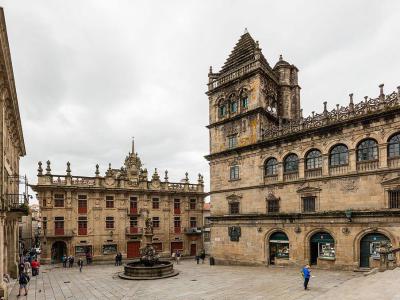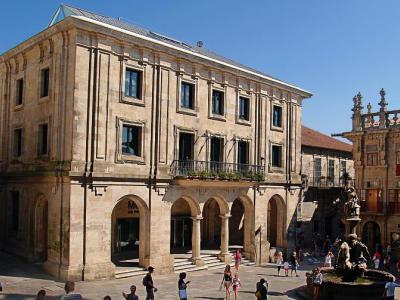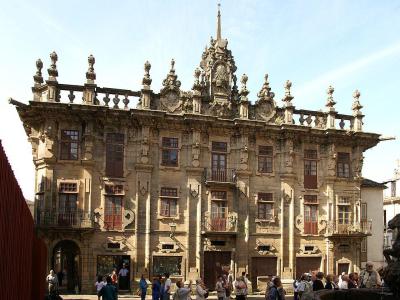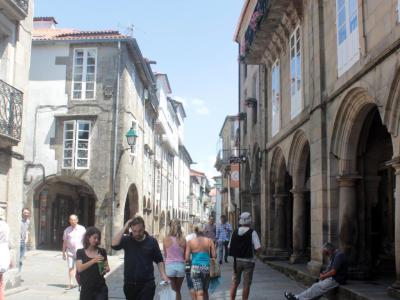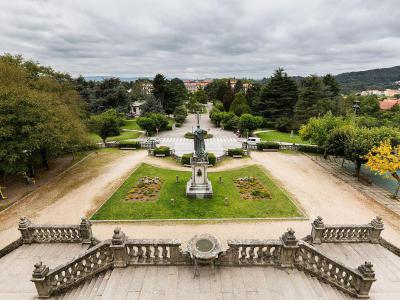Santiago de Compostela Introduction Walking Tour (Self Guided), Santiago de Compostela
Legend has it that after Saint James, one of the Twelve Apostles of Jesus, was martyred in Jerusalem in 44 AD, his followers carried his decapitated body by sea to Spain. Others claim that the saintly remains were miraculously taken up by angels and sailed to the coast of Galicia, where a massive rock closed around it and was later moved to its final resting place.
Either way, during the Middle Ages, pilgrims from all over Europe traveled on foot to Santiago de Compostela to visit the Apostle's tomb in the Cathedral of Santiago (Catedral de Santiago), one of the most revered shrines in Christendom. This months-long journey came to be known as the Way of Saint James (Camino de Santiago).
The discovery of the relics in the early 9th century gave Santiago de Compostela its present name. "Santiago" is the Spanish evolution of the Latin "Sancti Iacobi", which means Saint Jacob (the alternate name for Saint James), now revered as the patron saint of Spain. As for "Compostela", it is derived from the Latin "Campus Stellae," meaning a "field of stars." It refers to the legend that the Milky Way guided pilgrims to the tomb of Saint James.
Being the final destination of the pilgrimage route, the town flourished and became the capital of the Kingdom of Galicia. It also played a key role in the establishment of Spain as a Christian kingdom. At some point, it was even equal to Jerusalem and Rome as a pilgrimage destination.
Today, no matter how or why you arrive here, Santiago de Compostela remains an attractive place to visit. The UNESCO-listed historic center continues to draw thousands of modern-day pilgrims each year.
At the heart of the city, the magnificent Cathedral, an opus of divine craftsmanship, echoes the fervent aspirations of countless souls who have embarked upon the sacred Camino. Their weary steps culminate in awe-inspiring reverence before the hallowed tomb of Saint James.
Outside this ethereal sanctuary, the grand Workshop Square (Plaza do Obradoiro) is adorned with an ineffable grandeur of monumental buildings, such as the Rajoy Palace (Palacio de Rajoy) and the Catholic Kings' Hotel (Hostal dos Reis Catolicos), unfolding before the eyes of the pilgrims and wanderers as a sublime stage upon which the timeless tales of devotion and enlightenment are brought to life.
Reflecting the harmonious confluence of faith, history, and aesthetic splendor, together these luminous jewels beckon travelers to embark on a transformative journey, where mortal souls can find solace and ascend to the realms of reverence and enlightenment. If you wish to experience the enchanting embrace of Santiago de Compostela on your own, this self-guided walking tour is a good option.
Either way, during the Middle Ages, pilgrims from all over Europe traveled on foot to Santiago de Compostela to visit the Apostle's tomb in the Cathedral of Santiago (Catedral de Santiago), one of the most revered shrines in Christendom. This months-long journey came to be known as the Way of Saint James (Camino de Santiago).
The discovery of the relics in the early 9th century gave Santiago de Compostela its present name. "Santiago" is the Spanish evolution of the Latin "Sancti Iacobi", which means Saint Jacob (the alternate name for Saint James), now revered as the patron saint of Spain. As for "Compostela", it is derived from the Latin "Campus Stellae," meaning a "field of stars." It refers to the legend that the Milky Way guided pilgrims to the tomb of Saint James.
Being the final destination of the pilgrimage route, the town flourished and became the capital of the Kingdom of Galicia. It also played a key role in the establishment of Spain as a Christian kingdom. At some point, it was even equal to Jerusalem and Rome as a pilgrimage destination.
Today, no matter how or why you arrive here, Santiago de Compostela remains an attractive place to visit. The UNESCO-listed historic center continues to draw thousands of modern-day pilgrims each year.
At the heart of the city, the magnificent Cathedral, an opus of divine craftsmanship, echoes the fervent aspirations of countless souls who have embarked upon the sacred Camino. Their weary steps culminate in awe-inspiring reverence before the hallowed tomb of Saint James.
Outside this ethereal sanctuary, the grand Workshop Square (Plaza do Obradoiro) is adorned with an ineffable grandeur of monumental buildings, such as the Rajoy Palace (Palacio de Rajoy) and the Catholic Kings' Hotel (Hostal dos Reis Catolicos), unfolding before the eyes of the pilgrims and wanderers as a sublime stage upon which the timeless tales of devotion and enlightenment are brought to life.
Reflecting the harmonious confluence of faith, history, and aesthetic splendor, together these luminous jewels beckon travelers to embark on a transformative journey, where mortal souls can find solace and ascend to the realms of reverence and enlightenment. If you wish to experience the enchanting embrace of Santiago de Compostela on your own, this self-guided walking tour is a good option.
How it works: Download the app "GPSmyCity: Walks in 1K+ Cities" from Apple App Store or Google Play Store to your mobile phone or tablet. The app turns your mobile device into a personal tour guide and its built-in GPS navigation functions guide you from one tour stop to next. The app works offline, so no data plan is needed when traveling abroad.
Santiago de Compostela Introduction Walking Tour Map
Guide Name: Santiago de Compostela Introduction Walking Tour
Guide Location: Spain » Santiago de Compostela (See other walking tours in Santiago de Compostela)
Guide Type: Self-guided Walking Tour (Sightseeing)
# of Attractions: 13
Tour Duration: 2 Hour(s)
Travel Distance: 1.7 Km or 1.1 Miles
Author: DanaOffice
Sight(s) Featured in This Guide:
Guide Location: Spain » Santiago de Compostela (See other walking tours in Santiago de Compostela)
Guide Type: Self-guided Walking Tour (Sightseeing)
# of Attractions: 13
Tour Duration: 2 Hour(s)
Travel Distance: 1.7 Km or 1.1 Miles
Author: DanaOffice
Sight(s) Featured in This Guide:
- Plaza del Obradoiro (Square of the Workshop)
- Santiago de Compostela Cathedral
- Palacio de Rajoy (Rajoy Palace)
- Hostal dos Reis Catolicos (Hospital Real de Santiago de Compostela)
- Monasterio de San Martin Pinario (Monastery of San Martino Pinario)
- Plaza de la Quintana (Quintana Square)
- Mercado de Abastos (Santiago Food Market)
- Rúa Nova (New Street)
- Plaza de las Platerias (Silverware Square)
- Museum of Pilgrimages and Santiago
- Casa do Cabildo (Town Hall)
- Rua do Vilar (Vilar Street)
- Parque La Alameda (Alameda Park)
1) Plaza del Obradoiro (Square of the Workshop) (must see)
The Square of the Workshop in Santiago de Compostela is a historically and culturally significant square located in the heart of the old town. It is surrounded by four important buildings that symbolize the city's powers: the Santiago de Compostela Cathedral, representing religion; the Hostal dos Reis Católicos, symbolizing hospitality; the Pazo de Raxoi, representing governance; and the Colexio de San Xerome, symbolizing education.
The square is adorned with eight rays on its floor, commemorating the Camiño de Santiago pilgrimage route, and showcases a blend of architectural styles spanning over 700 years. It holds great symbolism as the end point of the Camino de Santiago, attracting pilgrims from around the world who enter the Santiago Cathedral through the renowned Portico de la Gloria.
The Square of the Workshop is a bustling hub of activity, where pilgrims celebrate their achievements and visitors explore the city's architectural treasures. It represents the culmination of spiritual journeys, the convergence of cultures, and the preservation of a timeless heritage in Santiago de Compostela.
The square is adorned with eight rays on its floor, commemorating the Camiño de Santiago pilgrimage route, and showcases a blend of architectural styles spanning over 700 years. It holds great symbolism as the end point of the Camino de Santiago, attracting pilgrims from around the world who enter the Santiago Cathedral through the renowned Portico de la Gloria.
The Square of the Workshop is a bustling hub of activity, where pilgrims celebrate their achievements and visitors explore the city's architectural treasures. It represents the culmination of spiritual journeys, the convergence of cultures, and the preservation of a timeless heritage in Santiago de Compostela.
2) Santiago de Compostela Cathedral (must see)
The Santiago de Compostela Archcathedral Basilica holds great significance as a religious and historical landmark. It is an integral part of the Metropolitan Archdiocese of Santiago de Compostela and forms a vital component of the Santiago de Compostela World Heritage Site.
The cathedral is renowned as the reputed burial place of Saint James the Great, one of the apostles of Jesus Christ. It stands as one of the few remaining churches in the world constructed directly above the tomb of an apostle, sharing this distinction with notable churches such as Saint Peter's Basilica in Vatican City, Saint Thomas Cathedral Basilica in Chennai, India, and the Basilica of Saint John in Izmir, Turkey.
Throughout history, the arch cathedral basilica has been a prominent pilgrimage site along the Way of Saint James since the Early Middle Ages. Pilgrims from various parts of the world embark on this pilgrimage route, and the cathedral serves as the traditional endpoint of their journey. The spiritual significance of this place and the devotion associated with Saint James have attracted countless pilgrims, making Santiago de Compostela a renowned destination for religious travelers.
Architecturally, the cathedral is a remarkable example of Romanesque design, with subsequent additions in the Gothic and Baroque styles. Its grandeur and architectural beauty captivate visitors as they explore its various facets.
Each of the cathedral's façades, along with their adjacent squares, forms expansive urban squares that contribute to the city's charm. The Baroque façade of Praza do Obradoiro square, completed by Fernando de Casas Novoa in 1740, is a notable highlight. Another Baroque-style façade, the Acibecharía façade, originally designed by Ferro Caaveiro and Fernández Sarela, underwent modifications by Ventura Rodríguez.
The Pratarías façade, constructed by Master Esteban in 1103, showcases the architectural legacy of the Romanesque era. However, the most significant and revered artistic masterpiece of the cathedral is the Pórtico da Gloria. Created by Master Mateo in 1188, this early Romanesque sculpture is a testament to the skill and artistry of its time.
The cathedral is renowned as the reputed burial place of Saint James the Great, one of the apostles of Jesus Christ. It stands as one of the few remaining churches in the world constructed directly above the tomb of an apostle, sharing this distinction with notable churches such as Saint Peter's Basilica in Vatican City, Saint Thomas Cathedral Basilica in Chennai, India, and the Basilica of Saint John in Izmir, Turkey.
Throughout history, the arch cathedral basilica has been a prominent pilgrimage site along the Way of Saint James since the Early Middle Ages. Pilgrims from various parts of the world embark on this pilgrimage route, and the cathedral serves as the traditional endpoint of their journey. The spiritual significance of this place and the devotion associated with Saint James have attracted countless pilgrims, making Santiago de Compostela a renowned destination for religious travelers.
Architecturally, the cathedral is a remarkable example of Romanesque design, with subsequent additions in the Gothic and Baroque styles. Its grandeur and architectural beauty captivate visitors as they explore its various facets.
Each of the cathedral's façades, along with their adjacent squares, forms expansive urban squares that contribute to the city's charm. The Baroque façade of Praza do Obradoiro square, completed by Fernando de Casas Novoa in 1740, is a notable highlight. Another Baroque-style façade, the Acibecharía façade, originally designed by Ferro Caaveiro and Fernández Sarela, underwent modifications by Ventura Rodríguez.
The Pratarías façade, constructed by Master Esteban in 1103, showcases the architectural legacy of the Romanesque era. However, the most significant and revered artistic masterpiece of the cathedral is the Pórtico da Gloria. Created by Master Mateo in 1188, this early Romanesque sculpture is a testament to the skill and artistry of its time.
3) Palacio de Rajoy (Rajoy Palace)
The Rajoy Palace is a prominent building that serves as the seat of the City Council and the presidency of the Junta de Galicia.
Constructed in the neoclassical style, the palace was commissioned by the Archbishop of Santiago, Bartolomé Raxoi Losada, in 1766. Its original purpose was to function as a seminary for confessors. The architectural work was entrusted to the French engineer Carlos Lemaur. The palace's façade features a representation of the battle of Clavijo and a sculpture of the Apostle Santiago, adding artistic and historical significance to the structure.
The palace is positioned on the western side of the Plaza del Obradoiro, effectively closing off that side of the square. It stands opposite the main façade of the Santiago de Compostela Cathedral. To the right of the palace is the Colegio de San Jerónimo, which currently houses the Rectorate of the University of Santiago. On the left side of the palace is the Hospital Real de los Reyes Católicos, a part of the Paradores Nacionales de España network.
In 2015, when UNESCO approved the extension of the Camino de Santiago in Spain to include the "Caminos de Santiago de Compostela: French Camino and Caminos del Norte de España," the Spanish documentation submitted to UNESCO included a "Retrospective Inventory - Associated Elements." This inventory recognized the Rajoy Palace as item number 912, highlighting its importance in relation to the Camino de Santiago.
The Rajoy Palace stands as a significant architectural and historical landmark in Santiago de Compostela. It symbolizes the region's cultural heritage and serves as a center for civic and governmental activities. Visitors to the Plaza del Obradoiro can appreciate the palace's elegance and its contribution to the rich tapestry of the city's history and identity.
Constructed in the neoclassical style, the palace was commissioned by the Archbishop of Santiago, Bartolomé Raxoi Losada, in 1766. Its original purpose was to function as a seminary for confessors. The architectural work was entrusted to the French engineer Carlos Lemaur. The palace's façade features a representation of the battle of Clavijo and a sculpture of the Apostle Santiago, adding artistic and historical significance to the structure.
The palace is positioned on the western side of the Plaza del Obradoiro, effectively closing off that side of the square. It stands opposite the main façade of the Santiago de Compostela Cathedral. To the right of the palace is the Colegio de San Jerónimo, which currently houses the Rectorate of the University of Santiago. On the left side of the palace is the Hospital Real de los Reyes Católicos, a part of the Paradores Nacionales de España network.
In 2015, when UNESCO approved the extension of the Camino de Santiago in Spain to include the "Caminos de Santiago de Compostela: French Camino and Caminos del Norte de España," the Spanish documentation submitted to UNESCO included a "Retrospective Inventory - Associated Elements." This inventory recognized the Rajoy Palace as item number 912, highlighting its importance in relation to the Camino de Santiago.
The Rajoy Palace stands as a significant architectural and historical landmark in Santiago de Compostela. It symbolizes the region's cultural heritage and serves as a center for civic and governmental activities. Visitors to the Plaza del Obradoiro can appreciate the palace's elegance and its contribution to the rich tapestry of the city's history and identity.
4) Hostal dos Reis Catolicos (Hospital Real de Santiago de Compostela) (must see)
The Hospital Real de Santiago de Compostela, a prestigious five-star hotel in Santiago de Compostela, is renowned as one of the world's oldest continuously operating hotels. Its location in the heart of the city adds to its historical and cultural significance. Recognized as the "most beautiful hotel in Europe," it captivates visitors with its stunning architecture.
Queen Isabella I of Castile and King Ferdinand II of Aragon, known as the Catholic Monarchs, founded the Hostal dos Reis Católicos in 1486. Their pilgrimage to Santiago de Compostela inspired them to establish a hostelry and hospital to assist weary pilgrims. Funding was secured in 1499, and construction commenced in 1501, lasting over a decade. For four centuries, it served as a sanctuary for pilgrims.
In 1953, the hospital was relocated to a new site, and in 1954, the building underwent an extensive renovation to become a hotel. Since 1986, it has been part of the prestigious Paradores network, which transforms historic structures into luxury accommodations. With 137 rooms, it stands as the largest and one of the finest establishments in the Paradores network. The hotel continues to offer free services to a limited number of pilgrims daily, upholding its hospitable tradition.
The Hospital Real de Santiago de Compostela holds a privileged position at the end of the Way of St. James, adjacent to the Santiago de Compostela Cathedral. Its construction, initiated in 1501, required the expertise of skilled craftsmen from across Europe. Architect Enrique Egas oversaw the project, resulting in a magnificent Plateresque façade. In 1526, King Carlos V completed the Plaza Obradoiro, connecting the Hostal to the grand Cathedral, creating a vast open plaza.
Featuring four interconnected courtyards, the building exudes charm and elegance. Two of the courtyards originate from the 1800s, while the earlier pair dates back to the 16th century, adorned with delightful water fountains. The Baroque-style remodeling added the later courtyards, further enhancing the hotel's allure.
Queen Isabella I of Castile and King Ferdinand II of Aragon, known as the Catholic Monarchs, founded the Hostal dos Reis Católicos in 1486. Their pilgrimage to Santiago de Compostela inspired them to establish a hostelry and hospital to assist weary pilgrims. Funding was secured in 1499, and construction commenced in 1501, lasting over a decade. For four centuries, it served as a sanctuary for pilgrims.
In 1953, the hospital was relocated to a new site, and in 1954, the building underwent an extensive renovation to become a hotel. Since 1986, it has been part of the prestigious Paradores network, which transforms historic structures into luxury accommodations. With 137 rooms, it stands as the largest and one of the finest establishments in the Paradores network. The hotel continues to offer free services to a limited number of pilgrims daily, upholding its hospitable tradition.
The Hospital Real de Santiago de Compostela holds a privileged position at the end of the Way of St. James, adjacent to the Santiago de Compostela Cathedral. Its construction, initiated in 1501, required the expertise of skilled craftsmen from across Europe. Architect Enrique Egas oversaw the project, resulting in a magnificent Plateresque façade. In 1526, King Carlos V completed the Plaza Obradoiro, connecting the Hostal to the grand Cathedral, creating a vast open plaza.
Featuring four interconnected courtyards, the building exudes charm and elegance. Two of the courtyards originate from the 1800s, while the earlier pair dates back to the 16th century, adorned with delightful water fountains. The Baroque-style remodeling added the later courtyards, further enhancing the hotel's allure.
5) Monasterio de San Martin Pinario (Monastery of San Martino Pinario) (must see)
The Monastery of San Martiño Pinario holds a significant place in the region's history. While little remains of the original medieval structures, the monastery has been rebuilt since the sixteenth century and continues to be an important landmark in the city. It is the second largest monastery in Spain, surpassed only by San Lorenzo de El Escorial.
The origins of the monastery date back to around the year 899 when it was built on the site of a chapel called Corticela, dedicated to Santa Maria. The chapel was a part of the Santiago de Compostela Cathedral, but when Alfonso III of Asturias and Bishop Sisnando began constructing a new cathedral, the Benedictine monks moved to the new monastery. A later monastery was built to replace the original one, and its church was consecrated in 1102 by Bishop Diego Gelmírez. However, little remains from that era.
During the Middle Ages, the Monastery of San Martiño Pinario grew in power and wealth, becoming the richest and most influential monastery in Galicia by the end of the fifteenth century. This led to significant reconstruction efforts starting in the sixteenth century. The monastery gained control over most of the monasteries in Galicia and held immense influence in the region.
The construction of the current church began in the late sixteenth century, under the guidance of Archbishop Juan de Sanclemente Torquemada and the architect Mateo López. After López's death in 1606, Benito González de Araujo took over the project. The church's facade faces west, opening to the square of San Martín. It features a magnificent altarpiece structure made of stone, divided into three sections and adorned with fluted columns. The main dedication of the church is to the Virgin Mary and the Benedictine order.
The origins of the monastery date back to around the year 899 when it was built on the site of a chapel called Corticela, dedicated to Santa Maria. The chapel was a part of the Santiago de Compostela Cathedral, but when Alfonso III of Asturias and Bishop Sisnando began constructing a new cathedral, the Benedictine monks moved to the new monastery. A later monastery was built to replace the original one, and its church was consecrated in 1102 by Bishop Diego Gelmírez. However, little remains from that era.
During the Middle Ages, the Monastery of San Martiño Pinario grew in power and wealth, becoming the richest and most influential monastery in Galicia by the end of the fifteenth century. This led to significant reconstruction efforts starting in the sixteenth century. The monastery gained control over most of the monasteries in Galicia and held immense influence in the region.
The construction of the current church began in the late sixteenth century, under the guidance of Archbishop Juan de Sanclemente Torquemada and the architect Mateo López. After López's death in 1606, Benito González de Araujo took over the project. The church's facade faces west, opening to the square of San Martín. It features a magnificent altarpiece structure made of stone, divided into three sections and adorned with fluted columns. The main dedication of the church is to the Virgin Mary and the Benedictine order.
6) Plaza de la Quintana (Quintana Square)
Quintana Square is a prominent and historically significant public space in the city. It serves as the main square and is characterized by its unique architectural surroundings and rich cultural significance. Its construction dates back to around 1611 when the mayor of Compostela decided to transform the medieval cemetery of the Quintana de Mortos into a public square. The remains from the cemetery were relocated to San Domingos de Bonaval and later to Boisaca cemetery.
Masters Francisco Fernández de Araújo and José de la Peña de Toro were commissioned by Cathedral canon José Vega y Verdugo to carry out the construction of Quintana Square. As part of the project, an imposing wall was erected, serving as a screen that closed off the eastern facade of the cathedral, encompassing the main and apse chapels.
The square itself is divided by a staircase, which separates two distinct levels. The upper level is known as the "Quintana de Vivos" or the "Quintana of the living," while the lower level is referred to as the "Quintana de Mortos" or the "Quintana of the dead."
Quintana Square holds great significance during Jacobean Holy Years, which occur when Saint James' Day, July 25th, falls on a Sunday. During these years, pilgrims traverse the square to reach the basilica through the Holy Door. This pilgrimage allows them to earn a plenary indulgence, a spiritual benefit granted by Pope Alexander III in his 1179 bull, Regis aeterni.
The square serves as a popular venue for various events and gatherings. It hosts celebrations for Galician Literature Day, the National Day of Galicia, demonstrations, and commemorative events such as those organized by the Plataforma Nunca Máis. The square is also utilized by artists, like Susana Seivane, who utilize the space for musical concerts and performances.
Masters Francisco Fernández de Araújo and José de la Peña de Toro were commissioned by Cathedral canon José Vega y Verdugo to carry out the construction of Quintana Square. As part of the project, an imposing wall was erected, serving as a screen that closed off the eastern facade of the cathedral, encompassing the main and apse chapels.
The square itself is divided by a staircase, which separates two distinct levels. The upper level is known as the "Quintana de Vivos" or the "Quintana of the living," while the lower level is referred to as the "Quintana de Mortos" or the "Quintana of the dead."
Quintana Square holds great significance during Jacobean Holy Years, which occur when Saint James' Day, July 25th, falls on a Sunday. During these years, pilgrims traverse the square to reach the basilica through the Holy Door. This pilgrimage allows them to earn a plenary indulgence, a spiritual benefit granted by Pope Alexander III in his 1179 bull, Regis aeterni.
The square serves as a popular venue for various events and gatherings. It hosts celebrations for Galician Literature Day, the National Day of Galicia, demonstrations, and commemorative events such as those organized by the Plataforma Nunca Máis. The square is also utilized by artists, like Susana Seivane, who utilize the space for musical concerts and performances.
7) Mercado de Abastos (Santiago Food Market)
The food market in Santiago de Compostela is a culinary haven nestled in the heart of the city's Old Town. This market is a must-visit destination for food lovers and tourists alike.
When you step into the Santiago food market, you are greeted with an awe-inspiring assortment of the finest Galician produce. The variety is simply mind-boggling: from an array of fresh fish and shellfish, vibrant fruits and vegetables, succulent meats and cheeses, to local wines, liquors, honey, and artisan bread.
The market has been a steadfast supplier of quality food and popular items to the people of Santiago de Compostela since its establishment in 1873. While the current building dates back to 1941, the market's rich history spans three centuries. Today, it operates under the management of a cooperative comprising 70 food producers and other business owners.
As you explore the Santiago food market, you'll encounter a kaleidoscope of colorful retailers and food sellers. Artisan stallholders proudly showcase their handmade creations alongside the seasoned wisdom of elderly women from neighboring villages, who sell seasonal treasures like garlic, cheese, and "grelos" (the leafy greens of turnips used in Galician broth, known as "caldo").
For those seeking iconic Galician delicacies, the market offers an abundance of regional specialties. Indulge in the delectable Padrón peppers, savor the tender octopus, sample the flavors of salted cod, or be adventurous and try the prized gooseneck barnacles. Additionally, the market boasts a wide variety of empanadas, savory pies that come in all shapes and sizes, each offering a unique blend of fillings and flavors.
When you step into the Santiago food market, you are greeted with an awe-inspiring assortment of the finest Galician produce. The variety is simply mind-boggling: from an array of fresh fish and shellfish, vibrant fruits and vegetables, succulent meats and cheeses, to local wines, liquors, honey, and artisan bread.
The market has been a steadfast supplier of quality food and popular items to the people of Santiago de Compostela since its establishment in 1873. While the current building dates back to 1941, the market's rich history spans three centuries. Today, it operates under the management of a cooperative comprising 70 food producers and other business owners.
As you explore the Santiago food market, you'll encounter a kaleidoscope of colorful retailers and food sellers. Artisan stallholders proudly showcase their handmade creations alongside the seasoned wisdom of elderly women from neighboring villages, who sell seasonal treasures like garlic, cheese, and "grelos" (the leafy greens of turnips used in Galician broth, known as "caldo").
For those seeking iconic Galician delicacies, the market offers an abundance of regional specialties. Indulge in the delectable Padrón peppers, savor the tender octopus, sample the flavors of salted cod, or be adventurous and try the prized gooseneck barnacles. Additionally, the market boasts a wide variety of empanadas, savory pies that come in all shapes and sizes, each offering a unique blend of fillings and flavors.
8) Rúa Nova (New Street)
The New Street, located in the historic center of Santiago de Compostela, is a street of great significance and one of the city's most emblematic thoroughfares. Running parallel to Vilar Street, it is renowned alongside another famous street, Franco Street, for its bustling atmosphere and the continuous flow of people passing through. The key reason behind this popularity is its direct connection to the Cathedral of Santiago de Compostela.
The New Street holds a historical charm that reflects its past as part of the old city. Its present appearance is characterized by the distinctive arcades that adorn a significant portion of Santiago's old town. In the past, these arcades were the site of a vibrant daily market where a variety of goods, including clothing, were sold. Alongside the market, a diverse array of shops lined the street, offering different types of products. The street acquired its name in the 12th century, and it is home to some of the city's most iconic landmarks.
Notably, the New Street houses the main theater of Santiago and the Galician Dramatic Center. Additionally, visitors can explore the Church of Santa María Salomé, the only church dedicated to the mother of the Apostle in Santiago de Compostela. Furthermore, one can access the Santa Cruz Palace, a 19th-century building that provides a glimpse into the city's architectural heritage. For those seeking more enchanting sights, Casa das Pombas, constructed in the 17th century, offers a captivating experience. Book lovers can also indulge in the Vetusta bookstore, a renowned establishment considered an icon within the old town of Santiago de Compostela.
The New Street holds a historical charm that reflects its past as part of the old city. Its present appearance is characterized by the distinctive arcades that adorn a significant portion of Santiago's old town. In the past, these arcades were the site of a vibrant daily market where a variety of goods, including clothing, were sold. Alongside the market, a diverse array of shops lined the street, offering different types of products. The street acquired its name in the 12th century, and it is home to some of the city's most iconic landmarks.
Notably, the New Street houses the main theater of Santiago and the Galician Dramatic Center. Additionally, visitors can explore the Church of Santa María Salomé, the only church dedicated to the mother of the Apostle in Santiago de Compostela. Furthermore, one can access the Santa Cruz Palace, a 19th-century building that provides a glimpse into the city's architectural heritage. For those seeking more enchanting sights, Casa das Pombas, constructed in the 17th century, offers a captivating experience. Book lovers can also indulge in the Vetusta bookstore, a renowned establishment considered an icon within the old town of Santiago de Compostela.
9) Plaza de las Platerias (Silverware Square)
Silverware Square derives its name from the silversmiths workshops that have occupied the arches beneath the cloister since the Middle Ages. The square's dominant feature is the Cathedral's only remaining Romanesque façade, which dates back to either 1078 or 1103. However, it suffered significant damage during popular uprisings against Archbishop Gelmírez in the 12th century. Fortunately, the façade was reconstructed a few years later. Over the centuries, additional Romanesque figures were incorporated from the Gate of Paradise on the Cathedral's north side, enhancing the façade's intricate iconography.
The frieze of the Romanesque façade is a masterpiece that combines apostles, angels, and signs of the zodiac. At the center stands a stylized Christ accompanied by St. James, the patron saint of Spain. The left-hand tympanum of the portals portrays Christ's temptation, while the right-hand one depicts scenes of the Passion, including Pilate's judgment, the scourging, and Judas' betrayal. The sidewalls are adorned with additional figures such as King David and the creation of Adam.
Bordering the Platerías portal are the base of the Clock Tower and the cloister wall. The cloister wall features Renaissance medallions inspired by Jacobean tradition, depicting scenes related to St. James. These include the movement of his relics and his transfiguration into a warrior. At the top of the wall, the medallions illustrate Christ's genealogy, with Mary and Baby Jesus prominently depicted in the right-hand corner. This section pays homage to Our Lady since the cloister is dedicated to her.
In the center of Silverware Square stands the Fountain of the Horses, set against the backdrop of the Casa del Cabildo. The Casa del Cabildo is adorned with typical baroque-style geometrical motifs, showcasing the artistic flair of Compostela. The fountain, added to the square in 1758 by architect Fernández Sarela, acts as a focal point and completes the square's architectural ensemble.
The frieze of the Romanesque façade is a masterpiece that combines apostles, angels, and signs of the zodiac. At the center stands a stylized Christ accompanied by St. James, the patron saint of Spain. The left-hand tympanum of the portals portrays Christ's temptation, while the right-hand one depicts scenes of the Passion, including Pilate's judgment, the scourging, and Judas' betrayal. The sidewalls are adorned with additional figures such as King David and the creation of Adam.
Bordering the Platerías portal are the base of the Clock Tower and the cloister wall. The cloister wall features Renaissance medallions inspired by Jacobean tradition, depicting scenes related to St. James. These include the movement of his relics and his transfiguration into a warrior. At the top of the wall, the medallions illustrate Christ's genealogy, with Mary and Baby Jesus prominently depicted in the right-hand corner. This section pays homage to Our Lady since the cloister is dedicated to her.
In the center of Silverware Square stands the Fountain of the Horses, set against the backdrop of the Casa del Cabildo. The Casa del Cabildo is adorned with typical baroque-style geometrical motifs, showcasing the artistic flair of Compostela. The fountain, added to the square in 1758 by architect Fernández Sarela, acts as a focal point and completes the square's architectural ensemble.
10) Museum of Pilgrimages and Santiago
The Museum of Pilgrimages and Santiago is a cultural institution dedicated to the pilgrimage phenomenon and the significance of the Camino de Santiago, as well as the historical and cultural aspects associated with the tomb of Apostle Santiago el Mayor. Established in 1951 as the Museum of Pilgrimages and Santiago, it was founded by Manuel Chamoso Lamas with the purpose of housing archaeological artifacts and other items related to Santiago de Compostela and the Jacobean pilgrimage.
The Museum of Pilgrimages and Santiago houses a diverse range of artifacts and displays related to pilgrimage culture and Jacobean traditions. Notable collections include those showcasing the music of the Camino de Santiago, featuring reproductions of the musical instruments depicted in the Pórtico de la Gloria. The museum also exhibits numerous statues and engravings depicting Apostle Santiago in various forms of iconography.
The Museum of Pilgrimages and Santiago houses a diverse range of artifacts and displays related to pilgrimage culture and Jacobean traditions. Notable collections include those showcasing the music of the Camino de Santiago, featuring reproductions of the musical instruments depicted in the Pórtico de la Gloria. The museum also exhibits numerous statues and engravings depicting Apostle Santiago in various forms of iconography.
11) Casa do Cabildo (Town Hall)
Town Hall is a remarkable architectural gem that captivates the attention of pilgrims and visitors to the city. This magnificent building serves as a decorative wall to enhance the grandeur of the cathedral square. Despite its appearance as a substantial structure, it is interesting to note that Town Hall is actually a stage curtain, merely four meters thick, designed to preserve the aesthetic appeal of the square.
The architectural design of Town Hall was envisioned by Clemente Fernández Sarela, a prominent architect of the Galician Baroque and a disciple of Fernando de Casas Novoa, the renowned author of the cathedral façade of the Obradoiro. Constructed between 1754 and 1758, Town Hall stands as one of the finest examples of Galician Baroque architecture, showcasing the artistic mastery of its creator.
The beauty of the Town Hall lies in its ornate adornments and the skillful use of granite plates carved into various geometric forms, which embellish the well-known baroque squares of Compostela. The building's exterior boasts impressive architectural features, including two large gargoyles positioned on the corners of its cornice, adding a touch of grandeur and intrigue to its appearance.
In 2011, Town Hall underwent a meticulous restoration process led by the Santiago Consortium, with the aim of including it in the group of museums located in the historic city center. Today, it serves as an exhibition building that welcomes visitors from all around the world. Situated in the Platerías square, alongside the cathedral and the former Bank of Spain building, which now houses the Museum of the Pilgrimages and of Santiago, Casa do Cabildo is an essential destination for anyone exploring the rich cultural heritage of the region.
The architectural design of Town Hall was envisioned by Clemente Fernández Sarela, a prominent architect of the Galician Baroque and a disciple of Fernando de Casas Novoa, the renowned author of the cathedral façade of the Obradoiro. Constructed between 1754 and 1758, Town Hall stands as one of the finest examples of Galician Baroque architecture, showcasing the artistic mastery of its creator.
The beauty of the Town Hall lies in its ornate adornments and the skillful use of granite plates carved into various geometric forms, which embellish the well-known baroque squares of Compostela. The building's exterior boasts impressive architectural features, including two large gargoyles positioned on the corners of its cornice, adding a touch of grandeur and intrigue to its appearance.
In 2011, Town Hall underwent a meticulous restoration process led by the Santiago Consortium, with the aim of including it in the group of museums located in the historic city center. Today, it serves as an exhibition building that welcomes visitors from all around the world. Situated in the Platerías square, alongside the cathedral and the former Bank of Spain building, which now houses the Museum of the Pilgrimages and of Santiago, Casa do Cabildo is an essential destination for anyone exploring the rich cultural heritage of the region.
12) Rua do Vilar (Vilar Street)
Vilar Street is a notable street with a rich architectural heritage and holds cultural significance for pilgrims on the Way of St. James.
Vilar Street has a long history of grand houses, which is evident as you continue your stroll. Along the street, you will encounter buildings in Renaissance, Baroque, and Neoclassical styles. These houses are characterized by their coats of arms and the quality of their ornamental wrought-iron and stone works. Notable examples include the Fundación Torrente Ballester at number 7, the Pazo de Monroy at number 18, and AFundación at number 19.
Continuing further, you will come across the old Casino of Santiago, founded in the 19th century. This exclusive social lounge was frequented by renowned figures such as Valle-Inclán, Castelao, and Saramago. Inside, you will find rich wood carvings and coffered ceilings that add to the ambiance of the space.
Next to the Pazo de Vaamonde, at number 59, you will encounter the narrowest street in the city, called Callejón de Entrerrúas. This charming passageway adds character to the area and is worth exploring.
At number 63, you will find the Municipal Tourist Information Office. This service, provided by Santiago City Council, offers valuable assistance to visitors, providing information on tourist, cultural, and leisure activities. The office offers a range of printed materials and can provide guidance on hotel availability, tourist products, and resources. The friendly staff is available to answer any inquiries and help visitors make the most of their stay in Santiago de Compostela.
Vilar Street has a long history of grand houses, which is evident as you continue your stroll. Along the street, you will encounter buildings in Renaissance, Baroque, and Neoclassical styles. These houses are characterized by their coats of arms and the quality of their ornamental wrought-iron and stone works. Notable examples include the Fundación Torrente Ballester at number 7, the Pazo de Monroy at number 18, and AFundación at number 19.
Continuing further, you will come across the old Casino of Santiago, founded in the 19th century. This exclusive social lounge was frequented by renowned figures such as Valle-Inclán, Castelao, and Saramago. Inside, you will find rich wood carvings and coffered ceilings that add to the ambiance of the space.
Next to the Pazo de Vaamonde, at number 59, you will encounter the narrowest street in the city, called Callejón de Entrerrúas. This charming passageway adds character to the area and is worth exploring.
At number 63, you will find the Municipal Tourist Information Office. This service, provided by Santiago City Council, offers valuable assistance to visitors, providing information on tourist, cultural, and leisure activities. The office offers a range of printed materials and can provide guidance on hotel availability, tourist products, and resources. The friendly staff is available to answer any inquiries and help visitors make the most of their stay in Santiago de Compostela.
13) Parque La Alameda (Alameda Park)
Alameda Park is a prominent urban park that holds great significance for both locals and tourists. Comprising three distinct areas, namely the Paseo da Alameda, the Carballeira de Santa Susana, and the Paseo da Ferradura or Paseo dos Leóns, the park has become a notable architectural and botanical landmark.
At the heart of the park lies the Paseo da Alameda, featuring a central promenade divided into three corridors that were originally designed for different social classes during the 19th century. The Paseo dos Leóns, accessible through a triumphal arch house, is adorned with flower beds, fountains, ponds, statues, and sculptures. Along the Paseo da Ferradura, visitors can admire a diverse range of ornamental tree species, such as oaks, eucalyptus trees, and horse chestnut trees.
The park reflects the passage of time through its spatial arrangement and architectural structures. It houses significant buildings including the Church of El Pilar, the Pavilion of Artistic and Industrial Recreation (the sole remaining structure from the Galician Regional Exhibition of 1909), a dovecote, a music kiosk, and an acoustic bench. Additionally, the park is known for its granite benches with artistic backings, crafted by the renowned Sargadelos factory, which contribute to its aesthetic appeal.
The Carballeira de Santa Susana, a magnificent oak grove, encircles a church built in the 12th century to accommodate the relics of Santa Susana. The park's origins date back to 1546 when Rodrigo de Moscoso Osorio y Álvarez de Toledo, the IV Count of Altamira, generously donated agricultural land for the enjoyment of the people of Santiago. In 1835, the Campo da Estrela and the Paseo da Ferradura were established, encircling the Carballeira de Santa Susana. The Paseo de los Leones, named after two lion-shaped sculptures relocated from Porta Faxeira, has gained renown as a remarkable section of the park.
With an expansive area of 56,087 square meters, Alameda Park boasts gentle slopes and stands out for its botanical and monumental significance. It offers numerous viewpoints from which visitors can admire the old city and enjoy panoramic vistas of Mount Pedroso, the Residence (Campus Sur or Campus Vida), and the southern outskirts of Santiago.
The park provides ample shaded areas, spacious lawns, and rest zones with comfortable benches. Clear signage guides pedestrians, and cycling is permitted within the park. It is also designed to be accessible for individuals with physical disabilities, offering amenities such as drinking water fountains, ponds, a children's playground, public restrooms, night lighting, an information point, and nearby parking areas (subject to fees). Alameda Park truly captures the essence of natural beauty and tranquility in Santiago de Compostela.
At the heart of the park lies the Paseo da Alameda, featuring a central promenade divided into three corridors that were originally designed for different social classes during the 19th century. The Paseo dos Leóns, accessible through a triumphal arch house, is adorned with flower beds, fountains, ponds, statues, and sculptures. Along the Paseo da Ferradura, visitors can admire a diverse range of ornamental tree species, such as oaks, eucalyptus trees, and horse chestnut trees.
The park reflects the passage of time through its spatial arrangement and architectural structures. It houses significant buildings including the Church of El Pilar, the Pavilion of Artistic and Industrial Recreation (the sole remaining structure from the Galician Regional Exhibition of 1909), a dovecote, a music kiosk, and an acoustic bench. Additionally, the park is known for its granite benches with artistic backings, crafted by the renowned Sargadelos factory, which contribute to its aesthetic appeal.
The Carballeira de Santa Susana, a magnificent oak grove, encircles a church built in the 12th century to accommodate the relics of Santa Susana. The park's origins date back to 1546 when Rodrigo de Moscoso Osorio y Álvarez de Toledo, the IV Count of Altamira, generously donated agricultural land for the enjoyment of the people of Santiago. In 1835, the Campo da Estrela and the Paseo da Ferradura were established, encircling the Carballeira de Santa Susana. The Paseo de los Leones, named after two lion-shaped sculptures relocated from Porta Faxeira, has gained renown as a remarkable section of the park.
With an expansive area of 56,087 square meters, Alameda Park boasts gentle slopes and stands out for its botanical and monumental significance. It offers numerous viewpoints from which visitors can admire the old city and enjoy panoramic vistas of Mount Pedroso, the Residence (Campus Sur or Campus Vida), and the southern outskirts of Santiago.
The park provides ample shaded areas, spacious lawns, and rest zones with comfortable benches. Clear signage guides pedestrians, and cycling is permitted within the park. It is also designed to be accessible for individuals with physical disabilities, offering amenities such as drinking water fountains, ponds, a children's playground, public restrooms, night lighting, an information point, and nearby parking areas (subject to fees). Alameda Park truly captures the essence of natural beauty and tranquility in Santiago de Compostela.
The Most Popular Cities
/ view all
